Fish Passage + Ecosystem Impacts
River systems are dramatically altered by the construction of a dam, which often has a lasting impact on interspecies relationships and overall habitat connectivity. More than just flowing water, rivers transport fish, sediment, and aquatic organisms between the headwaters (the smallest parts of river and stream networks) to the mouth (where the rivers discharge into coastal waters), sustaining healthy ecosystems along the way. Dams disrupt the system by acting as barriers that disconnect upstream and downstream river lengths, effectively weakening multiple ecosystems.
River Flow and Ecosystem Dynamics
Before European settlement, beaver dams and ponds were common in the smaller streams of the Narragansett Bay Watershed. However, these beaver dams did not generate the extent of changes associated with current dams in the watershed; beaver dams are relatively small, highly porous (leaky) and often seasonal or temporary. In contrast to beaver dams, dams constructed for industry and power along the rivers in the Narragansett Bay and coastal watersheds were large, permanent, and impervious, creating a large-scale shift in the flow and ecology of rivers. Dams effectively transform portions of a river ecosystem into a lake ecosystem (or reservoir). While different aquatic and terrestrial species thrive in these distinct habitats, both rivers and reservoirs can provide critical wetland habitat. These wetlands may serve as travel corridors; nesting, feeding, resting, nursery and brood-rearing sites; drinking water sources and escape cover; and provide seasonal breeding, migration and overwintering habitat for wildlife.
Free-flowing reaches of rivers and streams transport wood, rocks, and other natural debris downstream where they accumulate to create characteristic riffles (shallow rocky areas), pools, and meanders. These habitat features act as shelter for prey species and help to support coldwater fish species such as Brook Trout, Fallfish, Blacknose Dace, and Longnose Dace. There is also a unique macroinvertebrate fauna of mayflies, stoneflies, caddisflies, midges, craneflies, blackflies, dragonflies and damselflies, crayfish, and mollusks. In Rhode Island, due to habitat loss, dams, water pollution, and climate change, Eastern brook trout are listed as a Species of Greatest Conservation Need.

Coldwater streams supporting fish habitat. A dam in the middle of a forest may have a different level of attachment than one in the middle of town.
For more information about individual dams, please see the interactive map.

Diagrammatic section of free-flowing river
When dams are constructed, the river habitat above the dam is transformed into a lake habitat that supports warm-water species such as large and smallmouth bass, bluegill, and chain pickerel. Within these reservoirs, wetlands often emerge along the shoreline or in shallow areas, providing spawning and nursery habitat for a number of fish species. In addition, turtles, amphibians, and fish feed on the abundant invertebrate species that are found among aquatic plants. In some cases, rare and endangered species can be found in the novel lake ecosystems created by the reservoir. The presence of these species requires careful consideration of the possible dam scenarios to ensure that the selected alternative does not have a negative impact on the endangered species.
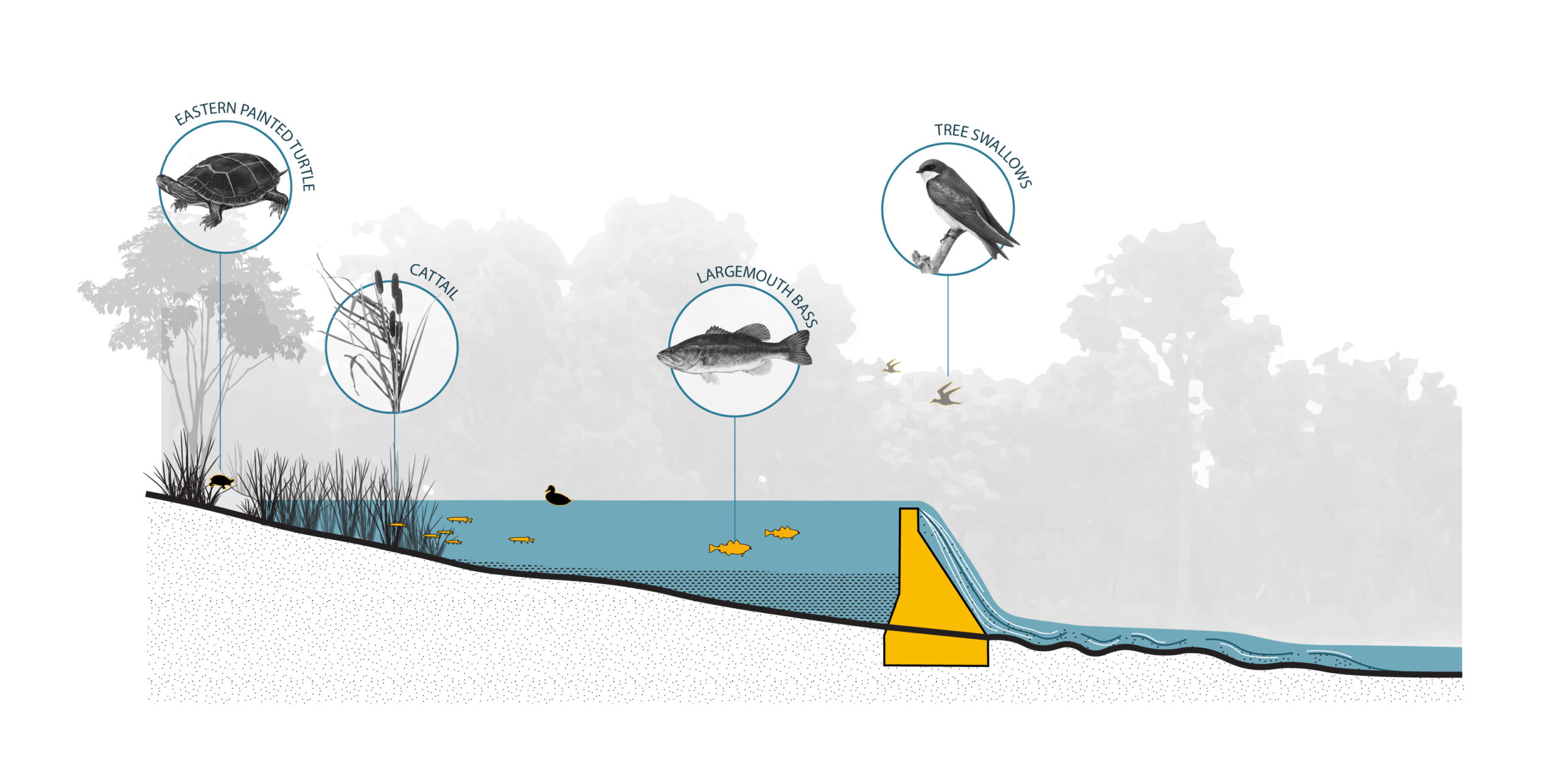
The river below the dam no longer receives input of wood, rocks, debris and sediment to create critical habitat features, and begins to behave more like a chute with reduced habitat diversity. Dams may also reduce genetic diversity within an ecosystem by separating resident fish populations and wildlife from their natural habitat and range. When free-flowing systems are dammed, there may be an influx of non-native species, which shifts predator-prey dynamics. While dams often have a negative impact on habitat connectivity and species diversity, there are some cases in which dams have prevented the spread of invasive species or disease from one fish population to another by blocking passage.

Miles of upstream river and stream opened to passage after dam removal.A dam in the middle of a forest may have a different level of attachment than one in the middle of town.
For more information about individual dams, please see the interactive map.
Migratory Fish Passage
Dams disrupt the migration and spawning of fish, which travel through waterways at different stages in their lives. Anadromous fish such as salmon, American shad, and river herring live in the ocean and travel back to fresh water every spring to spawn (reproduce). Using the earth’s magnetic field as a guide, they return to the exact location where they were born. Once they find their specific river, they use odor to locate their home stream. If unable to reach this stream, rather than spawn in a new location, some will continue searching until they have depleted all of their energy and die in the process. American eel are catadromous–they spawn in the Atlantic ocean and the young migrate into the river networks to feed and mature–often remaining for 5 to 40 years in freshwater ecosystems before returning to the ocean to reproduce. The migration of fish and eels is not only critical for the survival of the species, but it also contributes to the whole ecosystem as the fish recycle nutrients along the way.
Historically, the river systems of Narragansett Bay and the coastal ponds, which drain into the Narragansett Bay and Block Island Sound, supported healthy migration of River Herring, Atlantic Salmon, shad and American eels, allowing them to feed and reproduce. However, after the proliferation of dams, these species declined dramatically. Rhode Island’s once lucrative Atlantic salmon fishery collapsed in 1870, and the river herring fishery was significantly depleted by 1930.
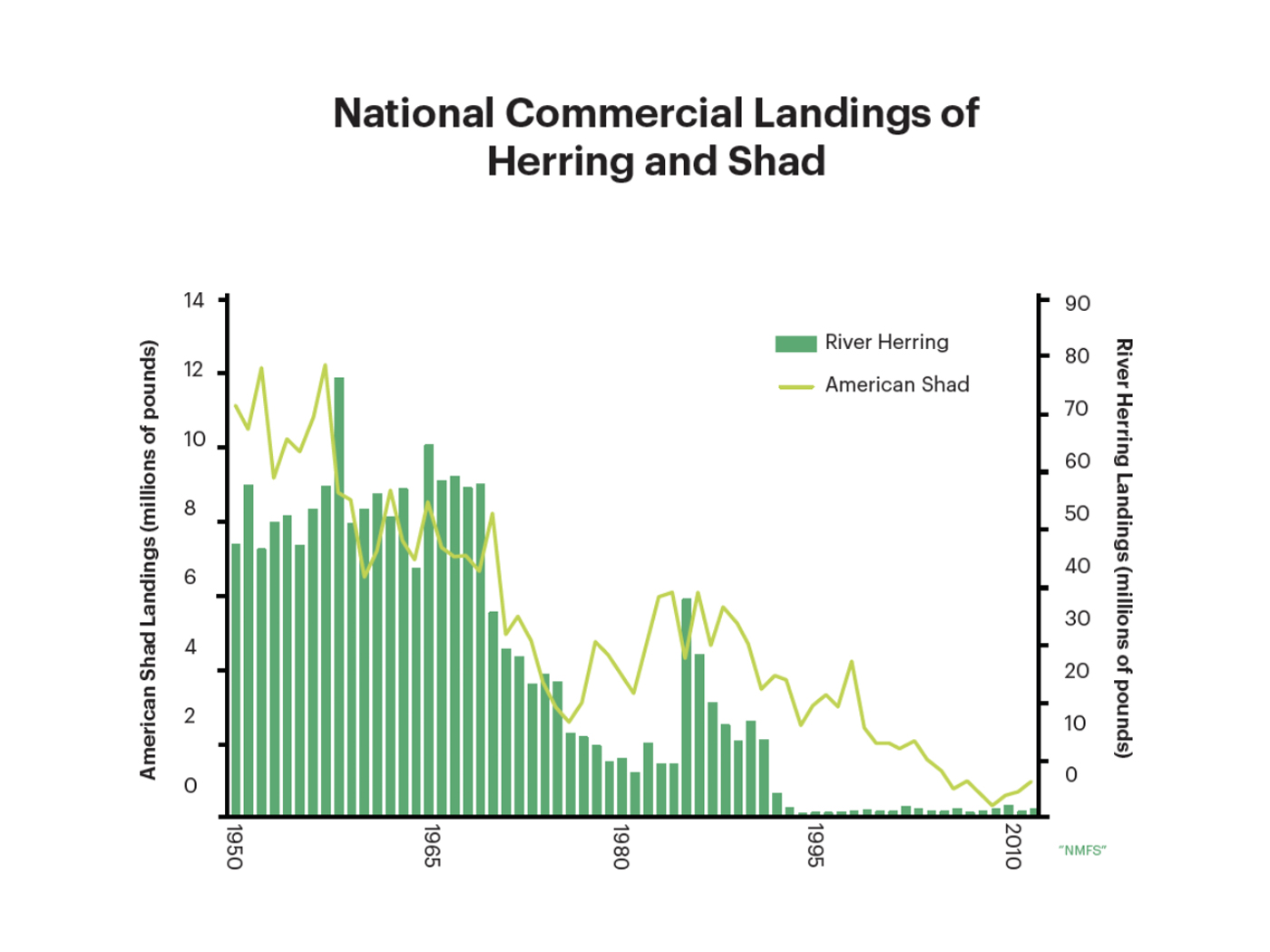
National commercial landings of herring and shad
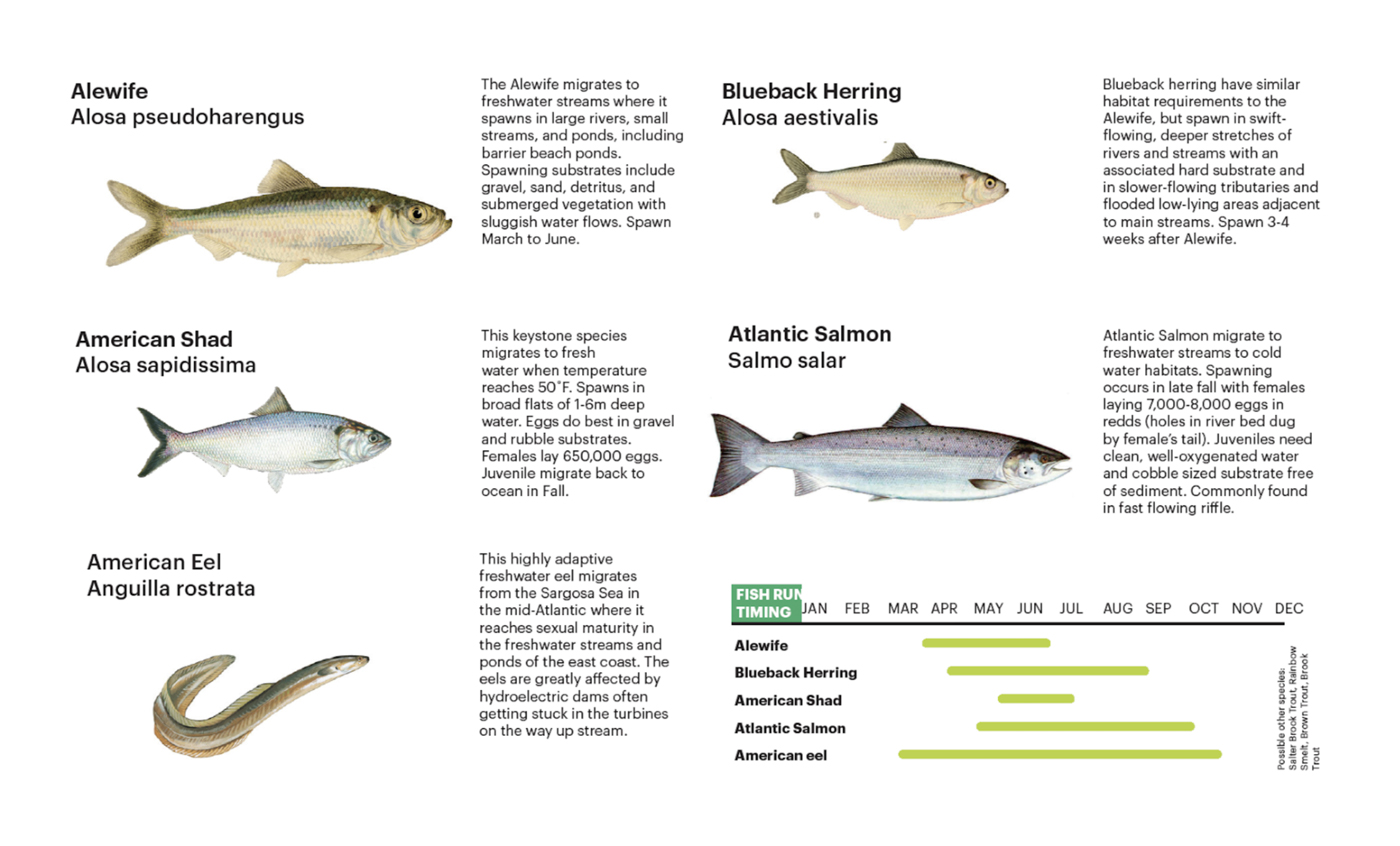
Anadromous fish found within the Narragansett Bay
Due to the importance of migrating fish species to the coastal rivers of Narragansett Bay, when trying to understand the impact of a dam, it is important to consider the locations of the dam within the watershed. Head of tide dams are the first dams on a river system. If these dams do not allow for fish passage, the whole river system is impassable to migratory fish, greatly diminishing their spawning habitat and ability to reproduce. Dams located on the main stem of river systems are particularly disruptive to fish migration since they cut off huge areas of the upstream watershed. When fish are stopped or delayed by a dam, even if the dam allows for some fish passage, they become easy prey and may experience significant population decline while predator species flourish.
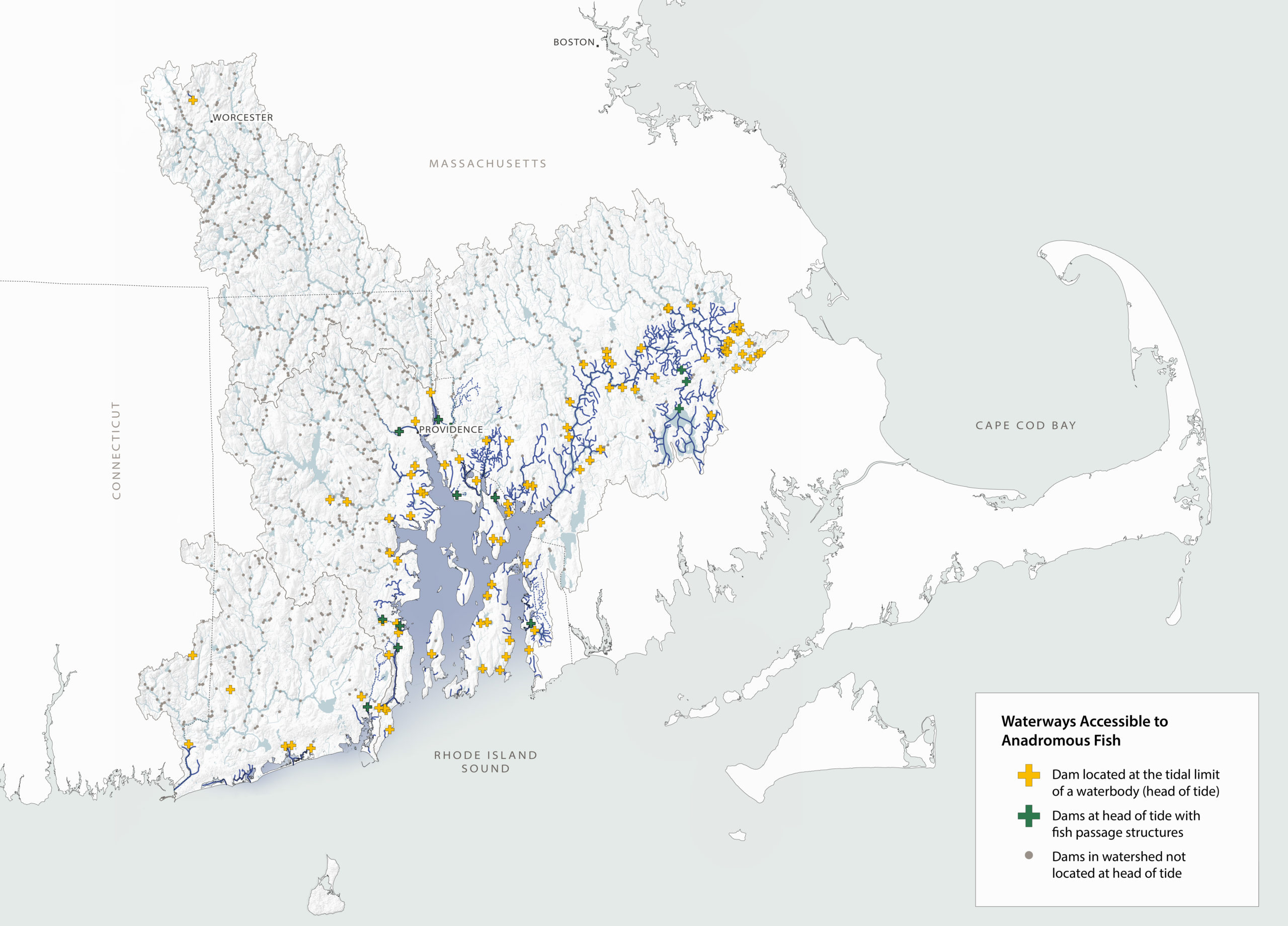
Anadromous fish passage at head of tide dams (dams located at the farthest point upstream where a river is affected by tidal fluctuations) within Narragansett Bay and coastal watersheds. A dam in the middle of a forest may have a different level of attachment than one in the middle of town.
For more information about individual dams, please see the interactive map.
In cases where dams have been removed along rivers in New England, some species of migratory fish quickly return, sometimes to rivers where they have not been seen for over 200 years. In areas where dam removal is not possible, alternative fishways may be an option to improve fish passage. See the “Scenarios” page for more information about the various dam alternatives to improve fish passage. A full ecological assessment is needed as part of any dam related project to evaluate the current wildlife and wetland habitats and to understand how they will be affected by the scenarios being considered.
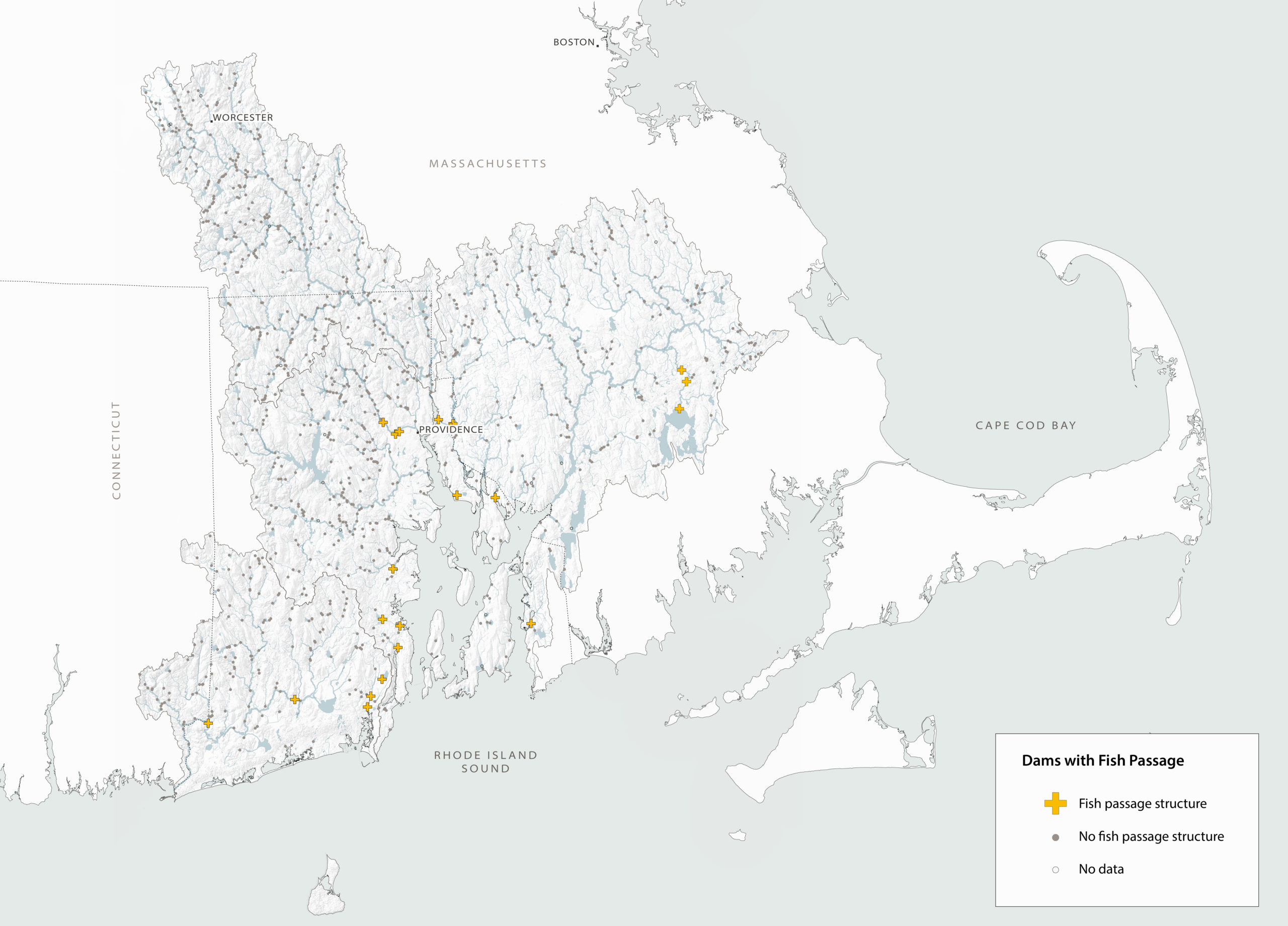
Dams with fish passage modifications. A dam in the middle of a forest may have a different level of attachment than one in the middle of town.
For more information about individual dams, please see the interactive map.